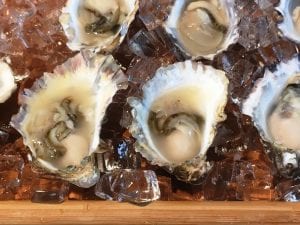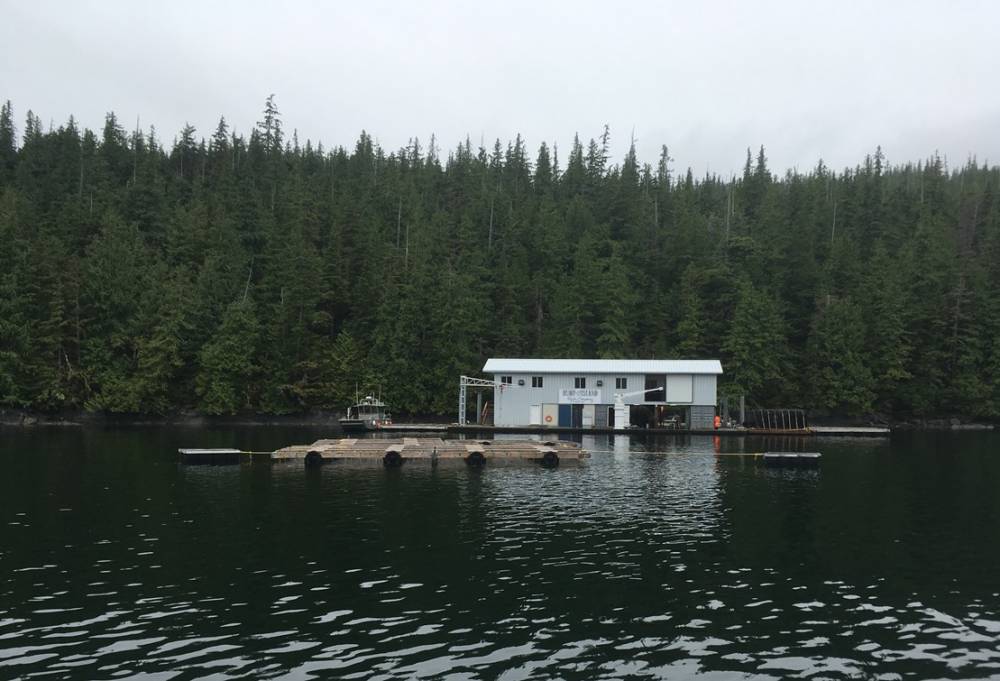
Hump Island Oyster Co. near Ketchikan. has been growing oysters since 2013. (KRBD photo by Leila Kheiry)
A bill that expands eligibility under Alaska’s mariculture revolving loan fund became law on Monday during a signing ceremony at Hump Island Oyster Co. near Ketchikan.
Now, shellfish hatcheries – seed providers — can be considered for low-interest loans from the state.
Mariculture is a fancy word for ocean-based farming. In Alaska, mariculture products usually are shellfish and, more recently, kelp.
At Hump Island Oyster Co., they grow both. But it started with oysters. Owner Trevor Sande gave a little history to Alaska Gov. Bill Walker at the farm site.
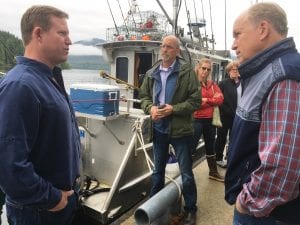
Trevor Sande, owner of Hump Island Oyster Co., (left) talks with Alaska Gov. Bill Walker about the farm. Also listening (center) are Ketchikan Gateway Borough Mayor David Landis and Julie Decker of the Alaska Fisheries Development Foundation. (KRBD photo by Leila Kheiry)
Sande said they wanted to start growing in 2012, but there was an oyster seed shortage that year. He said that’s one reason including hatcheries in the state loan fund is so important.
Sande said in 2013, they put their first seed in the water. To make that happen, he said they received funding through the state’s revolving loan fund.
“Without it, we wouldn’t be here,” he said. “We’re not quite in the black yet. It’s a long time to get a return in this farming industry. But I think it’s a good one.”
Oysters take three to five years to reach a marketable size – maybe longer. And while farms in the Midwest deal with insects, tornadoes, etc. Southeast Alaska mariculture farms have their own unique challenges.
Farm manager Buddy Anderson detailed a couple. The first was a big storm with 100-plus mph winds.
“I came to work that morning, and the 100-foot storage float was on the beach behind us in about four pieces,” he said.
Another storm came through a week later, Anderson said, causing even more damage. And then, there’s the starfish. He said they are an oyster farm’s worst enemy.
“Believe it or not, they take what they call their super-strength tentacles and they put one on each side of the oyster,” he said. “They’re able to pop the shell open, and they actually stick their stomach out and suck the oyster out. We lost a lot of oysters to that.”
But, they’ve managed to keep going, and keep growing. Anderson said they sell oysters mostly to Alaska restaurants up north. They also sell some locally, some to cruise ships, and some to restaurants Down South.
They added bull kelp to their product line last year, Sande said, and sell that to a Juneau kelp-products company. He hopes to see some profit from the entire operation very soon.
Walker said that House Bill 76, sponsored by Ketchikan Rep. Dan Ortiz, helps Alaska businesses like Hump Island Oysters at the very start of a new operation, when traditional loans are less likely to be approved.
Walker likened this bill to another seed bill he signed last week in Palmer.
“Without the seed you really can’t get them going,” he said. “What I look for in these kinds of businesses is what is the pinch point that we can help with.”
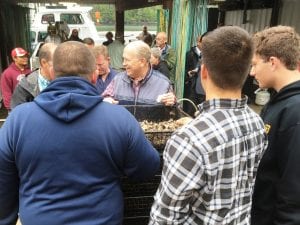
Alaska Gov. Bill Walker looks at some oysters that are still growing to market size. It takes three to five years, maybe longer, for an oyster to reach a commercial size. (KRBD photo by Leila Kheiry)
Julie Decker is with the Alaska Fisheries Development Foundation, and sits on the state’s mariculture task force. She was at the signing, too, and said hatcheries are a pinch point, and adding them to the loan fund will make a big difference.
“This developmental state of the industry, financing can be hard. Especially for a hatchery that needs to produce seed for a large industry,” she said. “So in this curve of industry growth, the loan funds can help stabilize their operations until the industry has the ability to grow up to where it needs to be to support that type of infrastructure.”
In addition to the bill, Gov. Walker signed an administrative order extending the mariculture task force’s mission. That group came up with a plan to encourage that industry in Alaska, and now members like Decker get to work on implementation.
Decker said there are 60 permitted sites in Alaska now, from Southeast to Homer. But only 20 are producing commercially, and of those just a handful are producing anything significant.
There are new ocean farms in the works, Decker said, and a lot of interest for more. Mark Scheer is working toward a permit for Premium Aquatics, a new 127-acre oyster and kelp farm near Craig on Prince of Wales Island.
He came along to witness the bill signing.
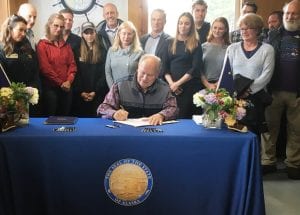
Gov. Bill Walker signs House Bill 76, allowing hatcheries to be eligible for the state’s mariculture revolving loan fund. (KRBD photo by Leila Kheiry)
“It’s really important – we need to develop infrastructure and this is part of the process of developing the infrastructure. For example, all of the kelp seed needs to be produced within state,” he said. “To do that, we need hatchery infrastructure like (Ketchikan-based hatchery) OceansAlaska. If Oceans is capable of producing more and has access to some money to help it get started in a more significant way, particularly on the kelp side, we build the infrastructure and the demand will follow.”
Decker said new sites like Scheer’s show the potential for growth.
“Silver Bay Seafoods out of Sitka has applied for an oyster farm site, as well,” she said. “There’s others in – I’m telling you, the Pribiloff Islands, the Aleutian Chain – there are people all over the state looking at this. It’s really exciting!”
Seaweed in particular seems to have sparked new interest, Decker said. Seaweed, or kelp, can be a bonus crop for oyster farmers because it’s planted and harvested during the down-time for oysters.
And, she said, unlike slow-growing bi-valves, a kelp crop provides faster cash for a new, struggling ocean farm.
Gov. Walker signed two other bills Monday in Ketchikan: HB18, which will allow the Ketchikan Chamber of Commerce to organize a Race Classic for the annual Race to Alaska; and HB354, which updates how Southeast Alaska Dive Fisheries Association assesses its membership.

